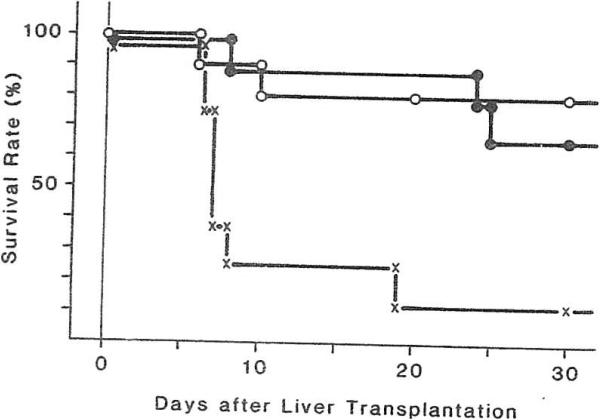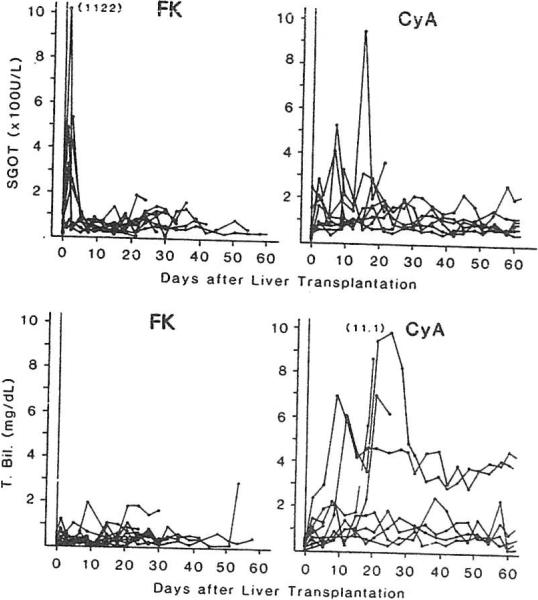IT has long been assumed, and for good reasons, that information about immunosuppression obtained with a specific organ should be applicable for all kinds of grafts.1 The drug FK-506 (FK), which was developed by scientists at the Fujisawa Pharmaceutical Co, Ltd, Osaka, Japan, has permitted the successful transplantation of heterotopic hearts in rats2,3 and kidneys in dogs.4,5 Information on liver transplantation using FK has been limited to preliminary observations in dogs with a maximum follow-up of 1 month.5 We report here an encouraging experience of liver transplantation in dogs. The results have been compared with those obtained with cyclosporine (CyA) at an earlier time.6
MATERIALS AND METHODS
Fasted beagle or mongrel dogs weighing 13 to 18 kg underwent orthotopic liver transplantation under anesthesia induced by thiopental, 25 mg/kg, and maintained by pentobarbital, 2 mg/kg, ketamine and 0.1 mg/kg pancuronium. Venovenous bypass was routinely used.6
Orthotopic liver transplantation in dogs is a difficult procedure, with such a high operative and perioperative mortality that discriminating drug studies can be done only with culled “good” experiments. Thus, as in past reports,6 survival for at least six days was a condition imposed for inclusion in the definitive series. Twenty-three transplantations were required to obtain ten definitive experiments. All 13 discarded recipients died during or within 48 hours of operation from technical complication not ascribable to immunosuppression, and most of the discarded animals never were given FK.
One gram cephalosporin was given intravenously during the operation and intramuscularly for the next three days. Two milligrams atropine sulphate was given intravenously during the operation, twice a day intramuscularly for the first week, and once a day for the second week to prevent or minimize vomiting and consequent intussusception. The daily intramuscular atropine dose was reduced to 1 mg during the third week.
The beagles were unrelated animals but from the same large colony. In the ten definitive experiments, the strain combinations were beagle donor to beagle recipient (B-B) in the first five and mongrel donor to beagle recipient (M-B) in the second five. The results were not different in the two subgroups, and consequently, all analyses were pooled.
Blood samples were taken every three mornings for the measurement of levels of BUN, creatinine, SGOT, and total bilirubin (TBil). A complete postmortem examination was performed immediately in animals that died. Tissues were fixed with formalin and stained with hematoxylin and eosin. Histopathologic changes will be mentioned only briefly because the only tissues were from the three animals who died.
A diet was started on the morning after the operation when the first dose of FK was given. The FK in powder form was placed in commercial capsules and given orally by digital placement in the oropharynx. The dose used was 1 mg/kg/d. After 1 month, the daily dose was reduced to 0.75 mg/kg.
The results with FK were compared with those in untreated animals (6 B-B and 2 M-B) previously studied as part of an investigation of the CyA analogue NVA2.6 A further comparison was made between the ten dogs treated with FK and nine dogs (four B-B and five M-B) treated previously with 20 mg/kg/d CyA for 30 days and 15 mg/kg/d thereafter.6
RESULTS
Survival
The fate of the ten individual dogs is shown in Table 1. Two dogs died after six and ten days because of intussusception and bile peritonitis, respectively. There was no sign of rejection in either liver. A third animal whose liver function had slowly deteriorated died after 55 days; the last bilirubin level was 2.9 mg/dL. At autopsy, there were no striking gross findings, but there were histopathologic findings of moderate rejection.
Table 1.
Survival and Cause of Death After Orthotopic Liver Transplantation in Dogs Receiving FK
| Animal No. | Survival (d) | Cause of Death |
|---|---|---|
| 1 | 6 | Intussusception |
| 2 | 10 | Biliary peritonitis |
| 3 | 30 | Alive |
| 4 | 31 | Alive |
| 5 | 32 | Alive |
| 6 | 36 | Alive |
| 7 | 39 | Alive |
| 8 | 44 | Alive |
| 9 | 55 | Emaciation, rejection |
| 10 | 60 | Alive |
The 1-month liver survival rates shown in Fig 1 are compared with those in nontreated controls and those of nine dogs (four B-B and five M-B) treated with 20 mg/kg/d CyA.
Fig 1.
One-month survival rates of untreated dogs, dogs treated with FK, and dogs treated with 20 mg/kg/d CyA. The controls and CyA-treated animals have been reported as part of another study.6 ×, Untreated control (n = 8);  , CyA 20 mg/kg/d (n = 9); ○, FK 1 mg/kg/d (n = 10).
, CyA 20 mg/kg/d (n = 9); ○, FK 1 mg/kg/d (n = 10).
Graft Function
The quality of liver graft function was uniformly good (Fig 2). The only animal whose bilirubin level rose to more than 2 mg/dL was the dog that died of rejection and emaciation after 55 days. Secondary increases in SGOT levels after recovery from the immediate ischemic insult either were low grade or did not occur at all (Fig 2).
Fig 2.
SGOT and TBil levels in dogs treated with 1 mg/kg/d FK and dogs treated with 20 mg/kg/d CyA. The CyA data have been published elsewhere.6 *Animal died.
The overall quality of liver function in the dogs treated with FK was better than that in the animals treated in our laboratory at an earlier time6 with CyA (Fig 2). The differences at 1 month were statistically significant (Table 2).
Table 2.
SGOT and TBil During First Month in Ten Dogs Treated by FK and Nine Dogs Treated by CyA
| Preoperative | 3 d | 7 d | 15 d | 24 d | 30 d | |
|---|---|---|---|---|---|---|
| SGOT (U/L) | ||||||
| FK | 47.2 ± 29.6 | 83.1 ± 81.9 | 42.2 ± 16.0 | 52.5 ± 38.9 | 84.8 ± 25.3 | 73.2 ± 50.1 |
| CyA | 62.1 ± 70.7 | 152.2 ± 78.7 | 187.7 ± 165.7 | 132.3 ± 56.6 | 132.3 ± 56.6 | 111.2 ± 65.3 |
| P value | NS | NS | <.05 | <.05 | <.05 | NS |
| TBil (mg/dL) | ||||||
| FK | 0.2 ± 0.1 | 0.3 ± 0.2 | 0.3 ± 0.2 | 0.5 ± 4.0 | 0.7 ± 0.6 | 0.2 ± 0.1 |
| CyA | 0.2 ± 0.2 | 1.0 ± 0.6 | 1.0 ± 0.9 | 1.9 ± 1.5 | 2.2 ± 2.2 | 2.2 ± 1.0 |
| P value | NS | <.05 | <.05 | <.05 | <.05 | <.05 |
CyA data from experiments previously reported.6
Weight and Well-Being
The only animal with serious emaciation was the B-B dog that died with moderate rejection after 55 days (Fig 3). This animal lost half of her body weight in 2 months. In comparison, the course of the longest survivor to date, now 65 days, is also shown (Fig 3). The latter dog lost 2.5 kg within the first postoperative week but has maintained the new weight with a good appetite since. Hepatic and renal functions have been completely normal in this dog.
Fig 3.
The course after two B-B transplantations in dogs receiving 1 mg/kg/d FK. Note the progressive weight loss in the dog whose liver was undergoing low rejection. ○, OLTX-FK10. >60 days;  , OLTX-FK9, died at 55 days.
, OLTX-FK9, died at 55 days.
All seven of the survivors are clinically well from 35 to 65 days postoperatively.
DISCUSSION
The similarities between FK and CyA are at least as remarkable as the differences. Both drugs are produced by soil bacteria. Both are lipophilic and hydrophobic, have incomplete absorption from the gastrointestinal tract, and act mainly by inhibition of interleukin 2 synthesis and/or binding. It would be incredible if drugs as powerful as these did not have major toxicity, and some of the reports at this symposium will feature the toxicity of FK in dogs. Whether the side effects are relatively species specific remains to be seen because rats tolerate the drug so well.
In the meanwhile, the potency and potential value of FK has been evident even in the presumably unfavorable dog model. At this stage of postoperative evolution when seven of ten liver recipients are still alive 35 to 65 days postoperatively, this is the best crop of canine liver recipients ever produced in our laboratory over the last 30 years with single-drug therapy.
In these experiments and in companion studies of renal transplantation in dogs,7 there has been little evidence that FK has intrinsic hepatotoxicity or nephrotoxicity. The freedom from renal damage is a stimulus for further development of FK because nephrotoxicity is the most limiting feature for the present-day use of CyA.
The experience with CyA has shown that the absence of nephrotoxicity in dogs does not ensure the same thing in humans. Nevertheless, the emergence of a drug as powerful as FK invites other possibilities than merely using it as a single drug. The use of FK in subtherapeutic and minimally toxic doses as a component of multiple-drug therapy has been a central theme with all of the in vivo and in vitro inquiries presented from the University of Pittsburgh workers at this meeting.7-10
SUMMARY
Ten dogs that survived the perioperative events of liver transplantation were treated with 1 mg/kg/d oral FK. Eight of the recipients lived for at least 1 month postoperatively, and seven are still alive with normal hepatic function after 35 to 65 days. The consistency and good quality of results with this difficult transplant preparation using FK, in spite of its rumored great toxicity in dogs, have highlighted the importance of further developing the drug.
Acknowledgments
Supported by research grants from the Veterans Administration and Project Grant No. AM-29961 from the National Institutes of Health, Bethesda, MD.
REFERENCES
- 1.Starzl TE. Experience in Renal Transplantation. Saunders; Philadelphia: 1964. p. 360. [Google Scholar]
- 2.Ochiai T, Nakajima K, Nagata M, et al. Transplant Proc. 1987;19:1284. [PubMed] [Google Scholar]
- 3.Lee P, Murase N, Todo S, et al. Surg Res Comm. 1987 in press. [PMC free article] [PubMed] [Google Scholar]
- 4.Ochiai T, Nagata M, Nakajima K, et al. Transplantation. 1987 doi: 10.1097/00007890-198712000-00002. in press. [DOI] [PubMed] [Google Scholar]
- 5.Todo S, Makowka L, Starzl TE. Surg Res Comm. 1987 in press. [PMC free article] [PubMed] [Google Scholar]
- 6.Todo S, Porter KA, Kam I, et al. Transplantation. 1986;41:296. doi: 10.1097/00007890-198603000-00004. [DOI] [PMC free article] [PubMed] [Google Scholar]
- 7.Todo S, Demetris AJ, Ueda Y, et al. Transplant Proc. this issue. [Google Scholar]
- 8.Murase N, Lee P, Lei H, et al. Transplant Proc. this issue. [Google Scholar]
- 9.Zeevi A, Duquesnoy R, Eiras G, et al. Transplant Proc. this issue. [Google Scholar]
- 10.Makowka L, Chapman F, Qian S, et al. Transplant Proc. this issue. [Google Scholar]





